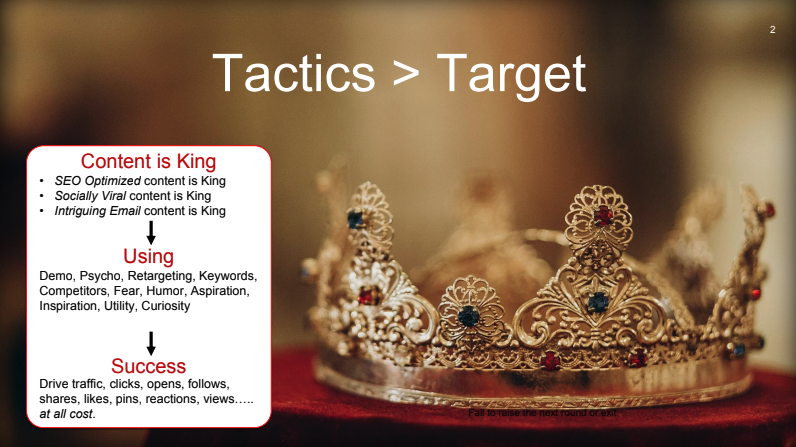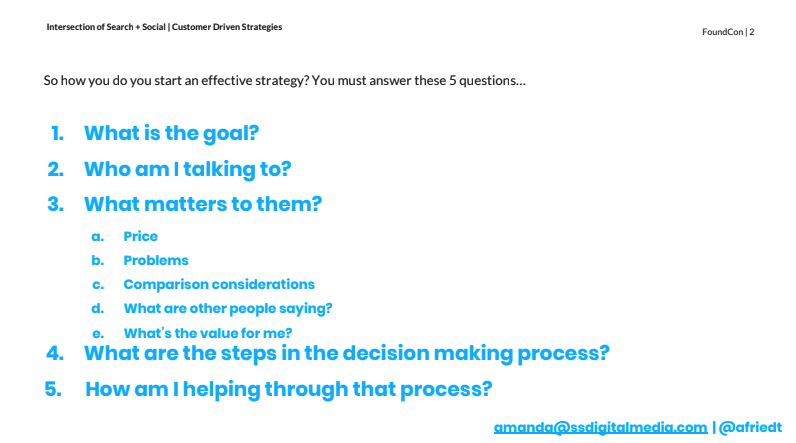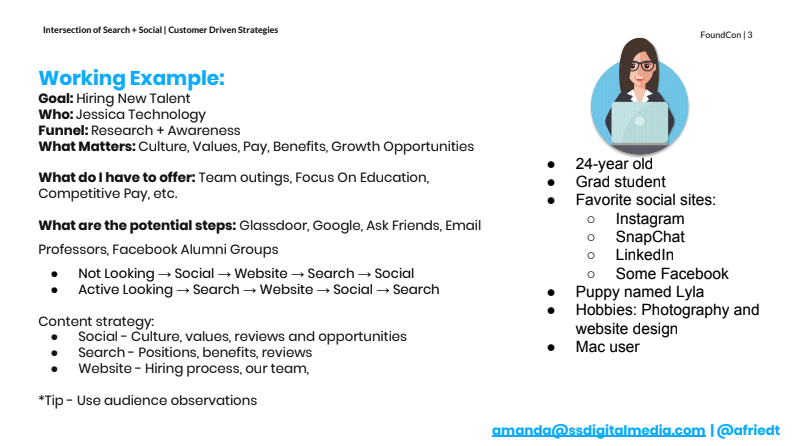Think about the last search you ran — not for your business, but as a consumer. What was the impetus to start that search? Maybe you needed to know how to fix a broken toilet (pretty urgent!) or you want to start planning next year’s garden (a long-term project). As you searched for information that you needed in the moment, you likely weren’t thinking about the intent of the content creators building the pages in the SERPs. You were focused on your needs and finding the information that best met those needs. So it makes sense that we need to consider a user-focused content strategy if if we want our audience to pay attention.
At Found Conference, SEO expert Byron Hardie presented his thoughts on what he calls “the marketing paradox.” Most marketers keep their brand in the forefront of their mind — sometimes forgetting to think about the customer as a separate being in a separate context. Many marketers understand the creation of content, making great viral material, writing awesome email headlines — but ignore the real needs of their customer. It’s human nature! From our own vantage point, the world is a very us-centric space.

Great marketing starts by thinking about how people solve problems agnostic of your brand. What are your customers’ pain points, and what triggered them to start the search that led to their interaction with you? Once you understand the mindset of your users, and the context of their searches, you can better inform those users on how your brand meets their specific needs.
Watch the Found Conference video featuring Byron and Amanda here.
Your content strategy needs to account for your entire marketing ecosystem
Amanda Farley, a partner at Detroit-based agency SSDM, says that you can put the people-focus back into your marketing by thinking outside the silo. However, using broad demographic traits makes it tough to think about individual users! Amanda recommends asking five questions as you humanize your readers — and as you learn how to engage with them:
What is the content goal?
When you’re creating a piece of content, you should start by setting a goal. Figure out what KPIs you want to meet: leads, engagement, sales, repeat buyers, hiring, whatever.
Keep asking “why.” Sure, you want to launch a Facebook campaign geared toward coffee enthusiasts: why? To reach more coffee enthusiasts? Why is that a goal? Because coffee enthusiasts will promote your product to other coffee enthusiasts, who may buy more of what you’re selling. But, is there a better way to achieve more sales and garner more influence? Could email, video, or in-store placement serve that goal better?

We’re all guilty of going with our guy (or our management’s gut) a little too much — and, for some reason, this usually comes out when someone higher up wants more Facebook like. If you’re working in an organization that values engagement for the sake of engagement — say, your management really wants to increase social media followers, and you’re not sure that allocating resources to social will move your brand toward its benchmarks — get clear on the goal.
Who is the content talking to?
Getting the right people in the door leads to better conversions and better conversations. Hardie mentions that reaching 200 of the right people is better than reaching a thousand uninterested users.
Who is your target audience? What makes one of these customers a qualified customer? How will reaching that user help you reach your goal?One way to do this, according to Farley, is to flip your usual concept of the marketing funnel. Instead of thinking about whether the customer lands in the buying process, think about where you land in the customer’s decision-making process. For example, say you’re recruiting for an entry-level sales job. From the perspective of a recent college graduate, where might she filter out your company from her options of places to apply? What might draw her closer to applying?

What matters to your audience?
What we think matters to our customer may not be their number one priority! You know your company’s strong points, but you may be broadcasting information that doesn’t align with your consumers’ needs. Don’t spend thousands on campaigns promoting your strengths in about how t x and y, only fo find out that 80 percent of your customers are seeking exclusively z.
Understand what kind of conversations are being built around your topics. A few ways to accomplish this:
- Research on the demographics of people visiting your Facebook page or website.
- Use Google Ads’ “Observation” feature, which allows you to monitor and set custom bids for criteria without restricting your reach.
- Check forums, social media, and other communication channels of your competitors. Join Facebook groups dedicated to your topic, or check out Instagram tags relating to your industry.
- Use internal search and your SEO tools to figure out where people are finding your products, and consider what the context of their searches may be.
Next, make that information part of your content. Once you know what’s important to your audience, make sure you’re including that information in your content! Talk about even the uncomfortable pieces. Maybe you’re targeting a group that wants an affordable product: it’s okay to lose that “aspirational feel” and promote your product as a low-price option. Maybe you’re offering a high-cost service that needs to be quoted out: if price matters to your customer, share your pricing process!
What are the steps in the audience’s decision-making process?
How will your customer decide whether to buy your product? Think through the problems your customer may be facing as they seek out information. This is Findability 101: perform some basic need-recognition, and figure out the pathway that will lead customers to your product.
Whose products are they comparing with yours? Furthermore, whose information is competing with yours? Many marketers are surprised to find that they lose customers to unexpected competition. To go back to our bathroom repair example, “how to fix a toilet flapper” may turn up answers from hardware stores, Amazon, DIY blogs, and HGTV — those links are competing for eyes, even if they aren’t competing directly for dollars. What specific value do you provide searchers, and how do let them know you’ll give them that value?
Once you have the attention of a user, you want to understand what type of user that person is. The right research can provide, if not explicit information on your customer’s buying journey, implicit information on where they stand in the buying process. You may not be able to ask every user who visits your site, “Are you looking to buy today? This month? This year?” However, you can see what types of topics your users are visiting, and extrapolate on that information to figure out where they are in the buying process.
How is my content strategy helping that process?
Don’t navel-gaze while asking this question. Again, you know your product: think about how that product appears to someone seeing it with fresh eyes. In email headlines, meta descriptions, social — anywhere you’re grabbing a user’s eyeballs — you should be demonstrating your brand’s solution to their problem or question. No matter what piece of content you’re creating, it needs to focus on one specific need, and identify how a user’s visit to your site will meet that need.
Dig through the layers of what you think should work, and try to focus on how that piece of content you’re considering will hit a new customer — or if it’ll reach that customer at all. Think about how you fit into the customer’s world — not how they fit into your world.
Want to talk about building a better content strategy through SEO, social media, and a full audience-driven experience? Set up a call with a DemandSphere strategist.
